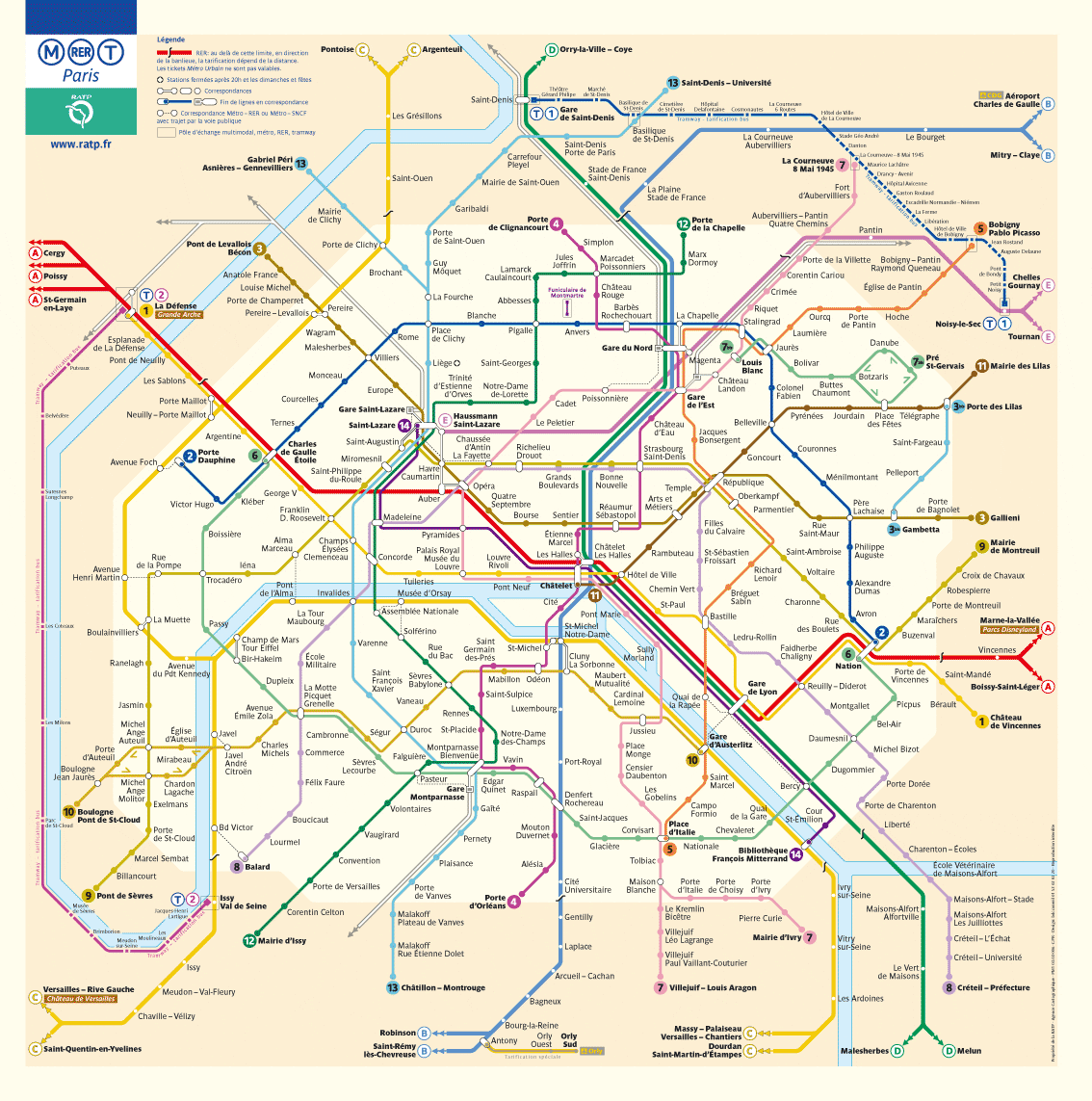When you’re traveling, you want to make sure that every penny counts towards enhancing your experience. From hotels to meals to attractions to airfare, you always want to make sure you’re getting the best possible experience for your dollar. However, most of us have a blind spot when it comes to traveling within a city. Even the most dedicated planners who have every second of every day planned out in advance usually forget to plan how they will get from place to place. Since Paris is basically a big circle that is only 6.5 miles in diameter, it’s actually a very walkable city, but walking isn’t always the most practical idea, and cabs can get very expensive very quickly. Thankfully, Paris offers you an amazing alternative in their top-notch Metro system, which in my opinion is among the best in the world. The service is quick, safe, inexpensive, and stations are literally everywhere – inside the peripherique, you are never more than a half-mile (or 10-minute walk) from a Metro station. In this post I am going to tell you everything you need to know to get the most out of the Metro, even if you are a newbie to the world of public transportation!
The Paris Metro is a (mostly) underground subway system with 14 different lines connecting the inner city. Each line is identified by a number, a color, and the two endpoint stations that determine the direction that a train is going. When you arrive at your accommodations in Paris, the first thing you should do is note which Metro station is closest to you. That is your “home” station, the one you will be leaving from in the mornings and returning to at night. Memorize its name, and know which lines run to and from that station. In some cases there may be several different stations that are close to your accommodations in which case it may be good to memorize all of them (however I prefer to just pick one, for simplicity’s sake).
It’s very important that you have access to a Paris Metro map. Many hotels have copies they can give you, and all Metro stations will have them mounted on the walls, but personally I like to keep one downloaded on my phone so that I can pull it up any time I need one. If you have a cell phone with you, I strongly recommend the CityMapper App , it makes using the Metro system a breeze. Otherwise, here is a good one you can download and/or print off and keep with you:

On this map, the thin lines are the Metro lines, and the thicker lines (red, blue, yellow, and green identified with letters A, B, C, and D instead of numbers) are the RER trains. The dotted T1 and T2 lines are the Tram. We’ll cover RER and Tram trains on another day – if you’re new to the Metro, I recommend sticking to the regular Metro lines and avoiding the RER or Tram lines unless you’re going outside of Paris proper.
First thing’s first – buying your tickets. These can be purchased at automatic ticket machines inside each Metro or at the ticket window when there is an employee present. When using the automatic machines, use the scroll bar and the green button to select “Acheter des tickets, coupons” then select “English.” The automatic machines take bills and coins as well as American credit cards. however when using a credit card it’s good to know the terms “patientez” which means the machine is reading your card have patience and “retirez carte” which means you need to remove your card from the reader. With American credit cards you’ll need to slowly insert your card, then remove it quickly when instructed. It may take a few tries to get it right the first time, but rest assured it will work. If you can’t seem to get it to work, go to the ticket window and they will help you.
The type of ticket you’ll want to buy depends on how you plan to use it. A regular ticket, called a t+, is priced at 1.90 Euro for a single ticket or 14.90 Euro for a book of ten, called a carnet. You can also buy a Mobilis pass, which gives you unlimited rides on one service day for only 7.50 Euro. If you’re going to take more than 4 Metro rides on any given day, then the Mobilis is the best value for your money.
*We find the carnet to be the best option for most of our guests as they end up walking more than expected, and occasionally hop in an Uber. They don’t usually take more than a few trips per day via metro. If you’ve purchased by the carnet, you can always pay it forward and pass any unused tickets to someone else upon your departure.
Other options include the Paris Visite, which is an unlimited daily pass that also includes discounts at many attractions. The Visite is pricier than the Mobilis, so you should only select it if you know you will utilize the discounts. To purchase the Mobilis or Visite from the automatic ticket machines, after selecting English, select “Other passes” and then scroll down until you find the option you want. It will ask you to select a secondary zone – choose Zone 2 unless you have a specific reason otherwise – and then ask you for the quantity of tickets you want. Finally, if you will be in Paris for at least a week, consider the Navigo Decouverte. The Navigo Decouverte (or ND) is a small plastic card that costs 5 Euro to buy (plus 5 Euro for a passport-style photo, which you can either bring from the US or buy at the Photomaton machines at most Metro stations), then you “charge” it up with either weeks or months of unlimited use. One week of use in zones 1 and 2 is about 20 Euro. For 35 Euro you can include all zones, as well as to/from the airports. Considering that a ticket to/from the airport is 10 Euro each way and seven days of Mobilis passes is 44 Euro, the Navigo Decouverte is the best deal for those with longer stays in the city of Paris. However, the ND begins on Monday morning and ends Sunday evening, so if you are arriving in Paris on a Friday, Saturday, or Sunday, you will want to wait until Monday to get your ND. You can get the ND card at a Metro station ticket window.
A few tips about Paris Metro tickets:
1. When going through the ticket booth, if you have a paper ticket, look for the entrances with small slits in the front. Place your ticket inside the slits (doesn’t matter which side is up). The ticket will go through the machine and pop up in a second slit on the top. If there is a white light on top, your ticket is valid and you are good to go. If there is a red light on top, your ticket is invalid and you will need to go back and enter a different one. Either way, make sure you take your ticket from the top slit or the gate will lock up and not let you through. If you have a plastic Navigo Decouverte, look for a purple bulls-eye symbol on top of the machine, and wave your card over that spot.
2. Keep your tickets throughout your ride. Occasionally RATP officials will stop you and demand to see your ticket, and if you can’t produce it, you’ll be hit with a stiff penalty that they force you to pay on the spot. It happens a lot, so make sure you don’t toss your tickets until you’ve exited the Metro station! There are also some stations that may require you to scan your used ticket to exit the station (typical for RER lines). If you don’t have your ticket, you’ll be stuck there with no way to get out.
3. If you have a Mobilis or Visite pass, you’ll need to hold onto that same small paper ticket until it expires. It’s good to mark it with your name and phone number, if you have one.
4. Keep tickets away from cell phones, credit cards, keys, coins, and any other magnetic or metallic materials. These will desensitize your tickets and make them useless. I recommend keeping your tickets in a zippered pocket on their own, away from anything else.
5. If you accidentally mix up your new and used tickets, look for a purple stamp on the front or back of your ticket, which signifies that it has already been used.
6. If you are making a connection to a different line at a particular station, you typically won’t need to scan your ticket again (with a few exceptions at some of the larger hubs). However, be careful not to accidentally exit the station when changing lines. Avoid doorways that have “Sortie” written on or above them, which are exits. Once you exit, you’ll need to use another ticket to get back in.
Once you have your pass, it’s time to use it! When you enter a Metro station, you’ll typically see a sign with a colored dot with a number in it. This indicates which line or lines run through that station. On the other side of the ticket booths, you’ll see signs with the colored dots, names of the endpoint stations, and arrows. These signs are pointing you toward the specific direction each line goes in. For example, lets say you are at the Tuileries metro station. The only line that runs through the Tuileries station is Line 1 (yellow). The endpoints for Line 1 at La Defense, on the west edge of Paris, and Chateau de Vincennes, on the east edge of Paris. If you want to go to a station on Line 1 that is east of the Tuileries station, you’ll follow the signs to La Defense. If you want to go to a station that is west of the Tuileries station, you’ll follow the signs to Chateau de Vincennes. Before you get to each individual train platform, you should see a sign that lists the current station you are at and all the remaining stations on that line in that direction. This is a good way to double-check the direction you’re going in. If you don’t see the station you want to end up at (or the station you are making a connection at) on that list, you’re going the wrong direction. Once you’re on the platform, just wait for the next train to arrive and hop on it! There are a small handful of double-sided platforms that have two different lines running on either side of the pedestrian platform. These are usually divided by columns, snack machines, and billboards, so make sure you stay on your side of the platform to catch the correct train.
Here are a few more tips on using the Paris Metro system:
1. When getting onto a train, be careful of the gap between the train and the platform. Though the gaps are usually small, sometimes there is a height difference that can trip you up if you’re not paying attention.
2. Good etiquette is to walk as far into the train as you can, so that the people behind you can also get on (in other words, don’t step onto the train and then block the doorway for everyone else).
3. The hinged seats near the door are called “jumper” seats – when the train is very crowded, it’s customary for the people in jumper seats to stand and fold their chairs up to allow for more space on the train.
4. If you are standing, make sure you have access to a hand rail – the trains do start and stop very abruptly and can send you flying into strangers if you don’t have something to balance yourself on.
5. The doors usually stay open for 10 seconds. When you hear the buzzer sound and the red light by the door go off, make sure to clear the doorway. Metro car doors do not have sensors, so they will close on you if you get in their way, and that is VERY painful and can be dangerous.
6. Though many cars do announce the name of a station when the train arrives, some do not, so pay attention at each stop to make sure you don’t miss yours. The names of each station are shown in large letters on the walls of each platform.
7. When you arrive at your destination, follow the signs that say “Sortie” which means exit. Most stations have several different exits to choose from that are labeled with the streets they open up to, so it helps to know what street you are trying to get to. Major attractions are sometimes listed in brown on exit signs to help tourists. The CityMapper App mentioned above is great about usually giving you the exit number you need.
8. There are very few escalators and almost no elevators, so be prepared to take a lot of stairs when using the Metro system.
The Paris Metro runs from 5:30 AM in the morning until 1:30 AM in the evening (though most stations have their final train around 1:10-1:15 AM) with most trains coming every 3-5 minutes during the day and every 8-10 minutes early in the morning and late in the evening. You can almost always find musicians performing in the hallways, on the platforms, or even in the cars themselves. These musicians actually have to audition before a panel and be approved, and their locations and playing times are regulated by the government. Most are one-man-bands, but occasionally you can find a 20-piece orchestra playing at the major hubs. If you hear someone you like, don’t be afraid to stop and have a listen – just make sure to donate a Euro or two in appreciation. Some of them even sell CDs, as well. In general, the Metro is very very safe to use, however there are some things to be aware of.
Metro Safety Tips:
1. Many homeless men and beggars take to the Metro platforms to get shelter from the cold or rain. They are harmless and will not bother you if you do not bother them.
2. Late at night, beware of drunks. Most are harmless, but occasionally inebriated riders will try to pick fights, hit on uninterested women, stumble around and knock into people, or throw up, and it’s best to stay away from them as much as possible.
3. Keep a close eye on all your belongings, especially when the Metro is crowded. Keep wallets, cell phones, passports, and other important items on inside pockets. Pickpockets take many forms, and often don’t look like what you would expect. My brother in law was approached by three teenage girls with large bags who asked for help getting to the airport, and thanks to his keen eye, he realized that one of them was trying to unzip his bag and get his wallet while the other one was distracting him with questions and the third was shielding her thief partner from the view of the other riders. He grabbed his bag and they ran off at the next station, realizing they had been caught. In general Parisians do not talk or make eye contact with strangers on the Metro, so if someone starts talking to you or getting unusually close to you, use caution, especially if they are in a group. Be particularly careful if you see a group of children or young teenagers traveling alone.
4. If possible, avoid traveling alone during very late hours. Most of the time you should be fine, but it can be a bit scary to be alone on a platform at night with a shady-looking stranger.
5. If you’re sitting in a “jumper” seat near the door, be very cautious of your belongings when doors are opening and closing. Many thieves will look for people in jumper seats who are using their cell phones or whose purses are sitting on their laps, and when the train arrives at a stop, they will grab the phone or purse and take off running. I recommend keeping your cell phones and wallets tucked away at all times on the train.
6. If you’re traveling with another person, especially if you’re in a group, make sure everyone in your party knows which station you are getting off at and where to meet if you get separated. It can be very scary to be lost in the Metro system with no idea where to go and no way to contact anyone, so have a game plan prepared in advance (and make sure everyone has enough money for a cab ride home, if it comes to that).
7. Pay attention to your surroundings. Don’t allow yourself to be distracted looking at a phone or map or digging in your bag or chatting with another person. Criminals target people who are distracted, so the more focused you can appear, the less likely you are to become a victim. If you think a pickpocket or thief may be targeting you, stare them in the eye and don’t look away. Most criminals in Paris are nonviolent, and they don’t want to go after someone who may fight back or chase them down or who may be able to recognize them later, so if you can let them know that you are aware of them and are not afraid, chances are they will get off at the next stop and find someone else to target.
I hope this has helped to demystify the Paris Metro system. It’s wonderfully inexpensive, safe, and easy to use, a great alternative to long feet-killing walks or expensive cab rides. If you have any question about using the Metro or if you have some tips of your own to add, leave it in the comments!








MeganHello! I am a blogger from Texas and we are traveling to Paris in November. Thank you for all the tips and best practices of the Paris metro. I’ve lived in London, DC – so this should be a breeze, but I guess it seems a bit more complicated to me – the ticket purchase that is. My fiance and I will have to sort that out, seeing that we are arriving on a Wednesday and leaving on Monday morning. Just wanted to say hello!
stacyHi Megan, thanks for the comment! I recommend buying a Mobilis (the unlimited day pass) each morning. It’s generally the cheapest way to go, and you won’t end up with any unused tickets at the end of your trip. Hope that helps!
Karen FairfieldThank you for this information! I have been researching Paris travel for months now and your post is the best that I’ve seen! We are traveling next year and I will keep this information for our trip!